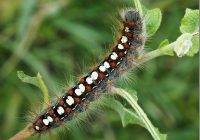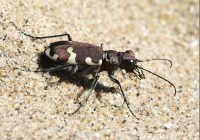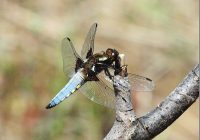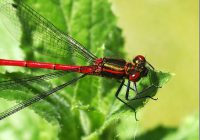Dr Phil Smith’s Wildlife Notes
May 2018
The Met. Office reckoned it was the warmest and sunniest May on record; it was also dry with measurable rainfall on only eight days. Forecasts of torrential thunder-storms came day after day during the last week but all we got were a couple of brief showers on 30th and 31st. The duneland water-table therefore fell rapidly, the Newest Green Beach at Ainsdale with 1000+ small Natterjack tadpoles on 2nd having completely dried up by 13th. Fortunately, tadpoles at several other sites, including the Devil’s Hole, survived until at least the end of the month.
As usual, May provided many wildlife highlights. Ainsdale Sandhills Local Nature Reserve never fails to impress, a visit on 4th with Trevor Davenport giving us great views of a male Whinchat and six Greenland Wheatears before we found several gorgeous Dune Pansies. White Satin moth caterpillars were abundant on the Creeping Willow, a precursor to a spectacular emergence of these ghostly white moths at the end of the month. Andrew Hampson of Gems in the dunes showed us a resplendent male Sand Lizard, the first I have seen for about three years. There were also many Northern Dune Tiger Beetles, leading me to plan a survey of these iconic Nationally Rare insects. The sunny weather certainly suited them; in three visits I recorded the locations of 275 adults on frontal dune ridges extending north for 850m from Ainsdale-on-Sea, easily my highest all-time count.
One of the hottest May Bank Holidays on record led to Formby being grid-locked. Hoping to avoid the crowd, I headed for the Devil’s Hole and saw only about a dozen people all afternoon. Resting for a few minutes on a grassy Rabbit-grazed bank, I enjoyed a wonderful display of tiny dune annuals, including Sea and Little Mouse-ear, Early Forget-me-not and Spring Vetch. It has been the best spring I can remember for the latter species. There were thousands of Natterjack tadpoles in the still-flooded slacks, lots of tiger beetles and a splendid ginger caterpillar of the rare Grass Eggar moth. On the downside, industrial-scale littering by earlier visitors to this beautiful place was disheartening. National Trust staff and volunteers filled nine large bin-bags here a few days later.
There wasn’t much time for birding but on 10th Marshside Nature Reserve provided the strange sight of a Barn Owl feeding on a dead Black-headed Gull; a pair of Mediterranean Gulls was apparently nesting nearby. An influx of 32 Swifts reflected ongoing migration, while two Glossy Ibis were rare visitors from southern or eastern Europe.
By mid-month, dragonflies were emerging in large numbers from dune wetlands, slack 50, north of Sands Lake supporting several Four-spotted Chasers, together with Azure and Blue-tailed Damselflies. On 19th, Downholland Brook at Alt Bridge had the first few Banded Demoiselles, numbers of this spectacular insect increasing to 18 before the month’s end. A male Brimstone butterfly was an unexpected bonus there. The Natterjack scrapes at Hightown also produced impressive numbers of dragonflies, especially Broad-bodied Chasers. At least 20 were present on 28th, together with six other species including my first Emperor of the year and three Black-tailed Skimmers.
May would not be complete without an organised trip round Altcar Training Camp to see the Green-winged Orchids. On 18th, Liverpool Botanical Society members and friends were treated to a sumptuous display of over 20,000 flower spikes, the largest population in the north of England of this nationally Vulnerable orchid. The sharp eyes of Josh Styles and others recorded several new plants for the estate, including Narrow-leaved Meadow-grass, Bristly Ox-tongue, Bastard Cabbage and the Nationally Scarce Purple Ramping-fumitory.
Orchids are also a feature of the Wildlife Trust’s Haskayne Cutting Nature Reserve, celebrating its 40th anniversary this year. Patricia Lockwood and I have been surveying the marsh-orchids there since 2012 to evaluate the effects of management by annual late summer mowing. On 31st, we counted 3323 Southern and Northern Marsh-orchids, a 43% increase on 2017’s total. Lesser Water-parsnip and Star-of-Bethlehem were new to the reserve list. Another highlight here was the discovery of Large Red Damselflies, two males and a female being found by Trevor Davenport and me on 28th. Although quite widespread in the region, this species is hard to find on the coastal plain.
Finally, I was surprised and delighted to hear that Joyce and David Jarvis had discovered Isle of Man Cabbage in the north Birkdale frontal dunes. I counted 20 plants there in full flower. This small colony, derived from a translocation in 2011, was thought to have been extinct since 2015. It was a welcome return of a British endemic plant and a Sefton Coast speciality!




